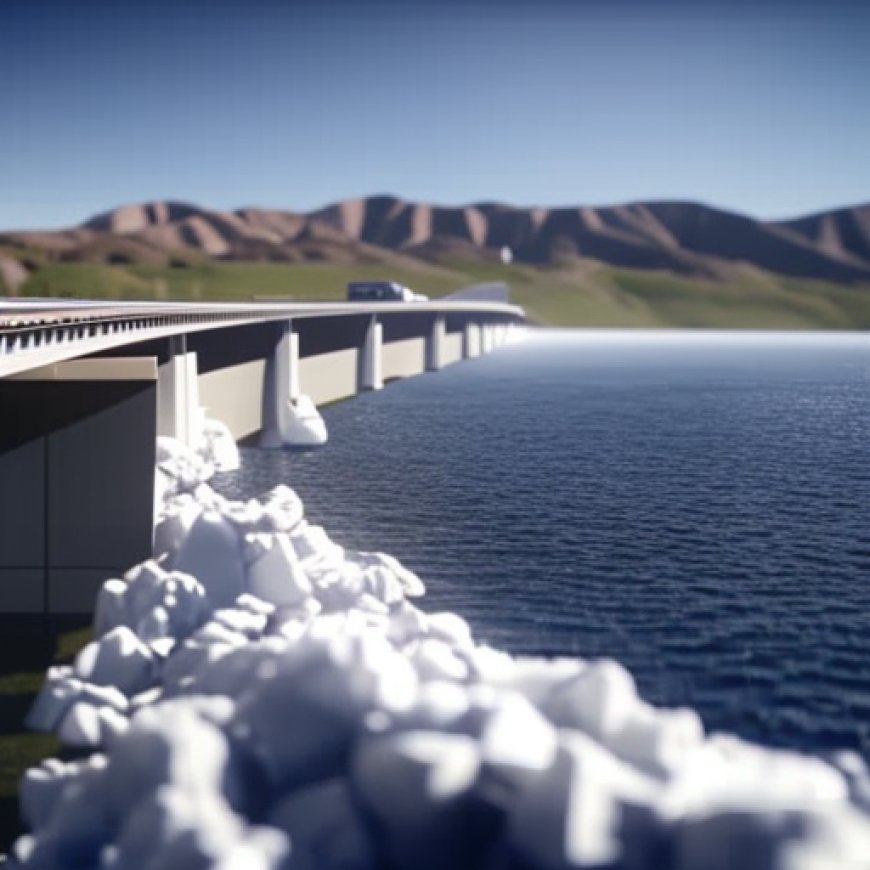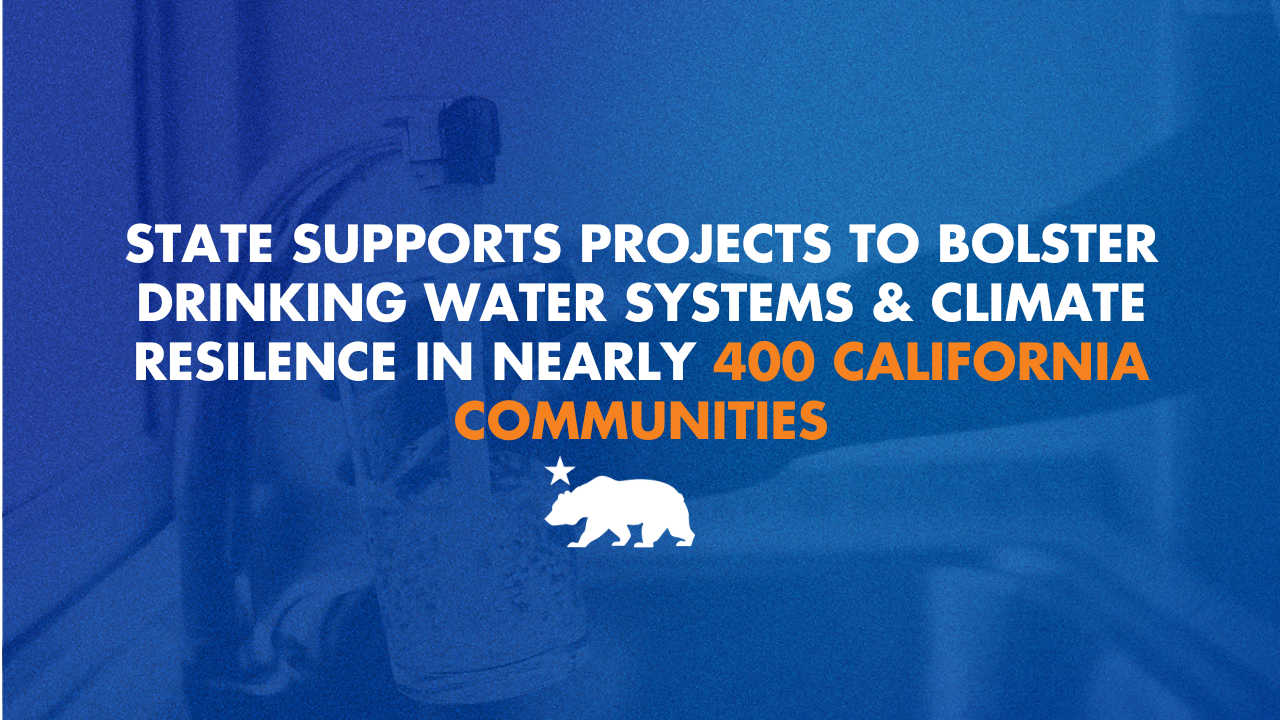State supports projects to bolster drinking water systems and climate resilience in nearly 400 California communities | Governor of California



What you need to know: The State Water Board distributed $880 million during the 2023-2024 fiscal year to projects that will benefit around 12 million Californians through improved drinking water, increased water supplies, and climate resilience efforts.
SACRAMENTO – Leveraging historic state and federal infrastructure investments to build climate resilience and boost water supplies, the State Water Resources Control Board distributed approximately $880 million to water systems and communities during the past fiscal year for projects that will benefit around 12 million Californians.
395 projects across the state have received funding to capture and recycle more water, recharge and protect groundwater, improve stormwater management, expand access to safe drinking water, and improve sanitation.
Since 2019, nearly 900,000 more Californians now have access to clean drinking water through state efforts including these investments and the Safe and Affordable Funding for Equity and Resiliency (SAFER) program, which is largely funded by cap-and-trade dollars.
“California is taking action to build a climate-resilient water system that meets the needs of our communities for the long haul. These projects breaking ground across the state will help hundreds of communities expand access to safe drinking water, improve stormwater management, and secure water supplies now and into the future.”
Governor Gavin Newsom
These projects advance the Newsom Administration’s all-of-the-above approach to building water resilience through storage, recycling, desalination, conservation, and more, and they further the state’s efforts to build more, faster through upgrades to critical infrastructure across the state.
This past year, nearly two-thirds of the State Water Board’s total financial assistance, or about $570 million, was given as grants for drinking water and wastewater projects in disadvantaged communities, as well as groundwater recharge and remediation and stormwater projects. A total of $62.8 million went towards new projects that will recycle, capture, and store more water, adding over 8,300 acre-feet per year to the state’s supplies.
Over the last three years, the State Water Board has distributed more than $5.2 billion to infrastructure projects and drinking water systems, drawing from multiple sources including the Clean Water and Drinking Water State Revolving Funds and the Bipartisan Infrastructure Law – unprecedented federal support that will reach $2.8 billion cumulatively for California by the end of 2026.
With estimates that hotter, drier conditions could reduce California’s water supply by up to 10% by the year 2040, the state is implementing multi-faceted solutions to safeguard and boost water supplies as outlined in the California Water Plan, Water Supply Strategy, and Water Resilience Portfolio.
Recent news
SDGs, Targets, and Indicators
-
SDGs Addressed or Connected to the Issues Highlighted in the Article
- Sustainable Development Goal 6: Clean Water and Sanitation
- Sustainable Development Goal 13: Climate Action
-
Specific Targets Based on the Article’s Content
- Target 6.1: By 2030, achieve universal and equitable access to safe and affordable drinking water for all
- Target 6.3: By 2030, improve water quality by reducing pollution, eliminating dumping and minimizing release of hazardous chemicals and materials
- Target 6.4: By 2030, substantially increase water-use efficiency across all sectors and ensure sustainable withdrawals and supply of freshwater to address water scarcity
- Target 6.5: By 2030, implement integrated water resources management at all levels, including through transboundary cooperation as appropriate
- Target 6.6: By 2020, protect and restore water-related ecosystems, including mountains, forests, wetlands, rivers, aquifers and lakes
- Target 13.1: Strengthen resilience and adaptive capacity to climate-related hazards and natural disasters in all countries
- Target 13.2: Integrate climate change measures into national policies, strategies and planning
- Target 13.3: Improve education, awareness-raising and human and institutional capacity on climate change mitigation, adaptation, impact reduction and early warning
-
Indicators Mentioned or Implied in the Article
- Increased access to safe drinking water for Californians
- Number of projects funded for capturing and recycling water
- Improved stormwater management
- Expansion of access to safe drinking water
- Improved sanitation
- Increase in water supplies through recycling, capturing, and storing water
- Reduction in water pollution and release of hazardous chemicals
- Implementation of integrated water resources management
- Protection and restoration of water-related ecosystems
- Strengthened resilience and adaptive capacity to climate-related hazards
- Integration of climate change measures into policies and planning
- Improvement in education and awareness on climate change
Table: SDGs, Targets, and Indicators
| SDGs | Targets | Indicators |
|---|---|---|
| Sustainable Development Goal 6: Clean Water and Sanitation | Target 6.1: By 2030, achieve universal and equitable access to safe and affordable drinking water for all | Increased access to safe drinking water for Californians |
| Sustainable Development Goal 6: Clean Water and Sanitation | Target 6.3: By 2030, improve water quality by reducing pollution, eliminating dumping and minimizing release of hazardous chemicals and materials | Reduction in water pollution and release of hazardous chemicals |
| Target 6.4: By 2030, substantially increase water-use efficiency across all sectors and ensure sustainable withdrawals and supply of freshwater to address water scarcity | Increase in water supplies through recycling, capturing, and storing water | |
| Target 6.5: By 2030, implement integrated water resources management at all levels, including through transboundary cooperation as appropriate | Implementation of integrated water resources management | |
| Target 6.6: By 2020, protect and restore water-related ecosystems, including mountains, forests, wetlands, rivers, aquifers and lakes | Protection and restoration of water-related ecosystems | |
| Sustainable Development Goal 13: Climate Action | Target 13.1: Strengthen resilience and adaptive capacity to climate-related hazards and natural disasters in all countries | Strengthened resilience and adaptive capacity to climate-related hazards |
| Sustainable Development Goal 13: Climate Action | Target 13.2: Integrate climate change measures into national policies, strategies and planning | Integration of climate change measures into policies and planning |
| Target 13.3: Improve education, awareness-raising and human and institutional capacity on climate change mitigation, adaptation, impact reduction and early warning | Improvement in education and awareness on climate change |
Source: gov.ca.gov








